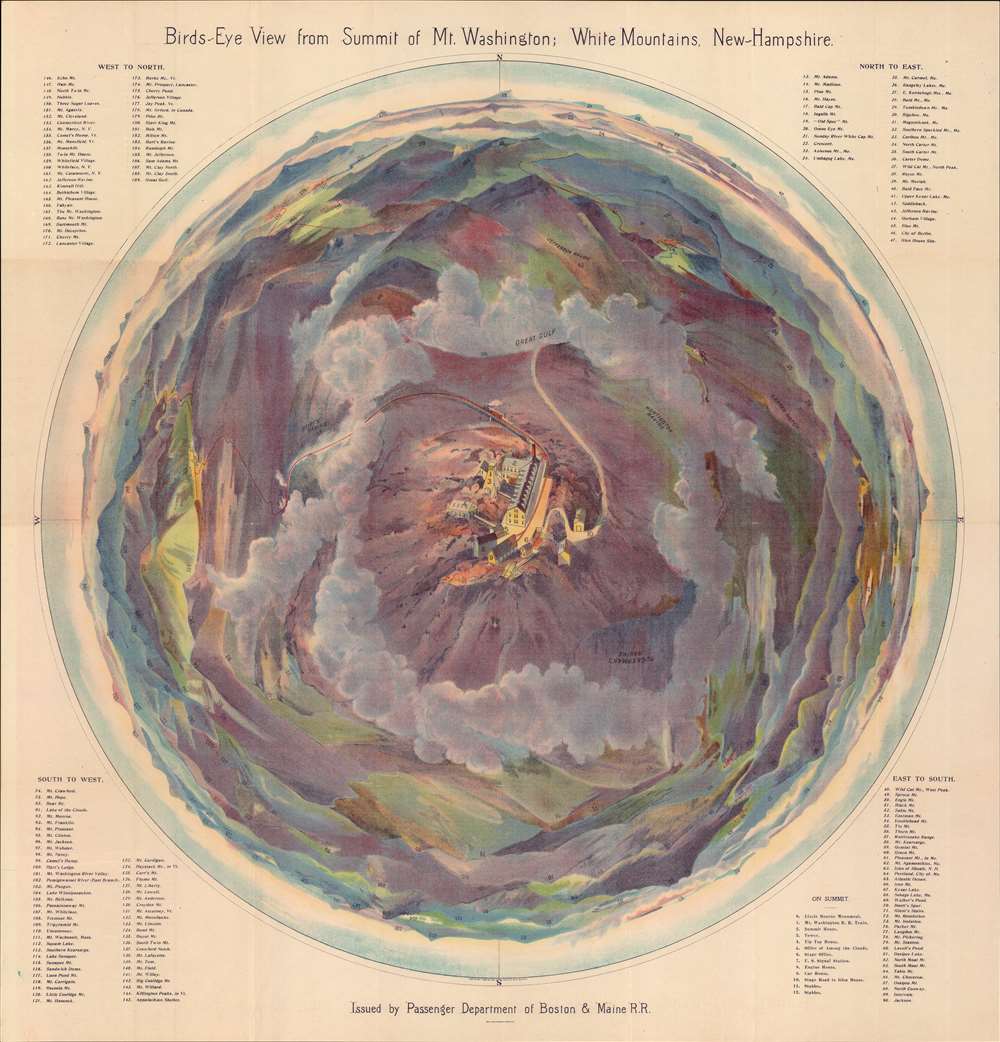This item has been sold, but you can get on the Waitlist to be notified if another example becomes available, or purchase a digital scan.
1902 Walker 'From the Summit' View of Mt. Washington, White Mountains, New Hampshire
MtWashington-walker-1902
Title
1902 (dated) 27.5 x 26.5 in (69.85 x 67.31 cm)
Description
Mount Washington
In the heart of New Hampshire's White Mountains, Mt. Washington is the highest mountain in the northeastern United States. With the Naturalism movement in the second half of the 19th century, the White Mountains in general and Mt. Washington specifically became a hotbed of tourism. On Mt. Washington several luxurious hotels opened, including Summit House (#2, 1852), a 64-foot-long (20 m) stone hotel anchored by four heavy chains, and Tip-Top House (#4, 1853). An observation tower (#3) was also built. Both a stage road (#6, 10) and the Mount Washington Cog Railway (#1, 1869) were constructed to facilitate travel - both remain in use today. Mount Washington even had its own newspaper, Among the Clouds, (#5) published each summer from 1885 to 1917 by Henry M. Burt.Chromolithography
Chromolithography, sometimes called oleography, is a color lithographic technique developed in the mid-19th century. The process involved using multiple lithographic stones, one for each color, to yield a rich composite effect. Oftentimes, the process would start with a black basecoat upon which subsequent colors were layered. Some chromolithographs used 30 or more separate lithographic stones to achieve the desired product. Chromolithograph color could also be effectively blended for even more dramatic results. The process became extremely popular in the late 19th and early 20th centuries, when it emerged as the dominant method of color printing. The vivid color chromolithography produced made it exceptionally effective for advertising and propaganda imagery.Publication History and Census
This view was drawn in 1902 and published in chromolithograph by George H. Walker of Boston for the Passenger Department of the Boston and Maine Railroad. The map is well represented institutionally, but is scarce to the market.Cartographer
George Hiram Walker (January 4, 1852 - November 14, 1927) was a Boston based publisher of books, views, and maps active in the late 19th and early 20th centuries. Born in Springfield, Vermont, Walker started his life as a dry goods merchant but developed an active interest in publishing during the early 1870s. Walker began publishing in 1878 when he partnered with an unknown New York Firm. Two years later, Walker brought the operation in house by partnering with his brother, Oscar W. Walker, in the opening of a lithography studio at 81 Milk Street, Boston. Shortly thereafter the firm expanded to new offices at 160 Tremont Street, Boston. The Walker brothers produced a large corpus of works, most of which focused on travel and tourism in New England. Walker also established the Walker-Gordon Milk Laboratory with Dr. Thomas Morgan Rotch and Gustave Gordon. This interesting investment was based on the premise that infant deaths could be avoided by providing higher quality milk. The company eventually became a great success, producing a high-quality cow milk that closely resembled human breast milk. In the process the Walker-Gordon laboratory developed many of the dairy health standards that are still with us today. Walker married Irene L. Loud on March 25, 1885. More by this mapmaker...

